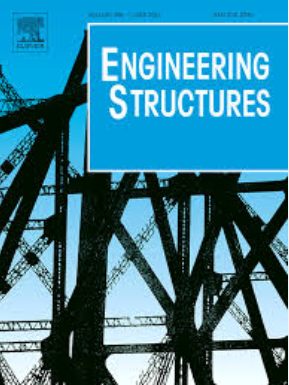Splice length and bond behaviors of doubled-row lapped bars in ultra-high performance concrete (UHPC)
IF 5.6
1区 工程技术
Q1 ENGINEERING, CIVIL
引用次数: 0
Abstract
This study investigated the bond behavior of hot-rolled ribbed bar (HRB) 500 in ultra-high performance concrete (UHPC) through direct tension tests on 11 groups of double-row spliced specimens. The variables included splice length, cover thickness, matrix type, fiber volume content, spacing between lapped bars, bar diameter, and bar grade. In addition, seven groups of anchorage specimens were designed to examine the differences between the two specimen types. Results indicate that the bond strengths of the spliced test ranged from 0.45 to 0.86 times those of the central pullout tests. The bond strength in spliced specimens was less affected by embedded length compared to anchorage specimens; however, it increased more significantly with a greater cover thickness. A size effect related to rebars was observed in the spliced specimens, whereas it was absent in anchorage specimens. The bond strength of UHPC with 2 % fiber was approximately twice that of ordinary concrete, but increased slowly when the fiber content increased to 3 %. A splice length of 12d led HRB 500 rebar (20 mm diameter) to yield, and a cover thickness of 3.8d was recommended to ensure yielding of a bar with a 3d splice length. A theoretical equation for calculating the UHPC bond strength was proposed that consider the bundle effect of bar lapping. Finally, a calculation model for predicting the yield splice length derived from the nonuniform bond stress distribution model, which aligned well with the experimental results of UHPC bond from existing studies.
求助全文
约1分钟内获得全文
求助全文
来源期刊

Engineering Structures
工程技术-工程:土木
CiteScore
10.20
自引率
14.50%
发文量
1385
审稿时长
67 days
期刊介绍:
Engineering Structures provides a forum for a broad blend of scientific and technical papers to reflect the evolving needs of the structural engineering and structural mechanics communities. Particularly welcome are contributions dealing with applications of structural engineering and mechanics principles in all areas of technology. The journal aspires to a broad and integrated coverage of the effects of dynamic loadings and of the modelling techniques whereby the structural response to these loadings may be computed.
The scope of Engineering Structures encompasses, but is not restricted to, the following areas: infrastructure engineering; earthquake engineering; structure-fluid-soil interaction; wind engineering; fire engineering; blast engineering; structural reliability/stability; life assessment/integrity; structural health monitoring; multi-hazard engineering; structural dynamics; optimization; expert systems; experimental modelling; performance-based design; multiscale analysis; value engineering.
Topics of interest include: tall buildings; innovative structures; environmentally responsive structures; bridges; stadiums; commercial and public buildings; transmission towers; television and telecommunication masts; foldable structures; cooling towers; plates and shells; suspension structures; protective structures; smart structures; nuclear reactors; dams; pressure vessels; pipelines; tunnels.
Engineering Structures also publishes review articles, short communications and discussions, book reviews, and a diary on international events related to any aspect of structural engineering.
 求助内容:
求助内容: 应助结果提醒方式:
应助结果提醒方式:


